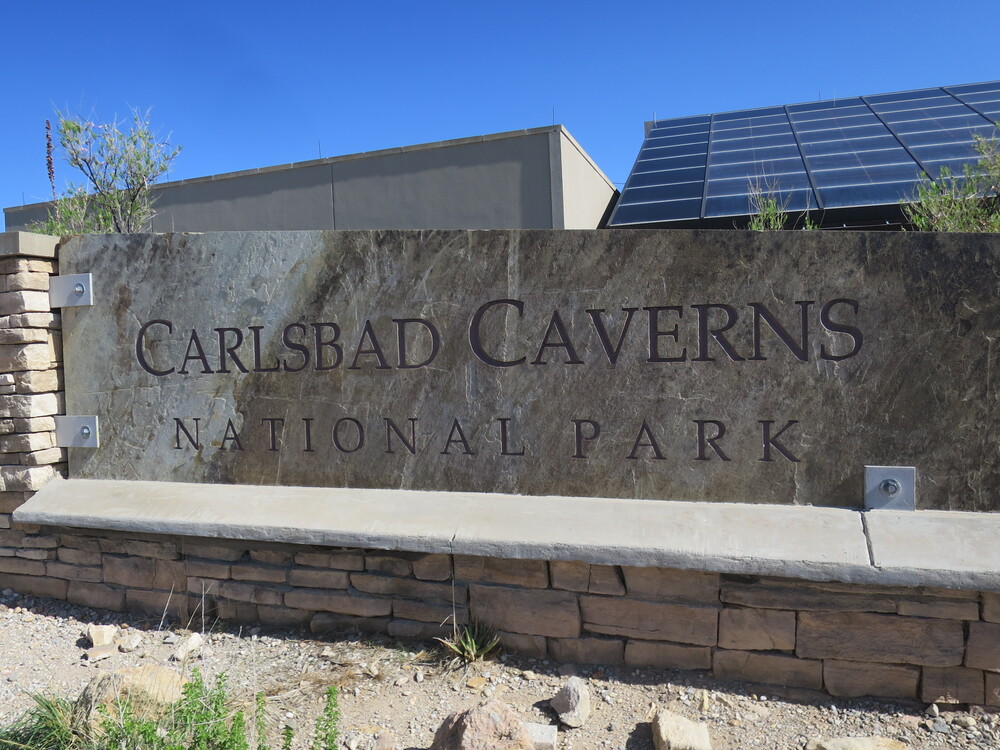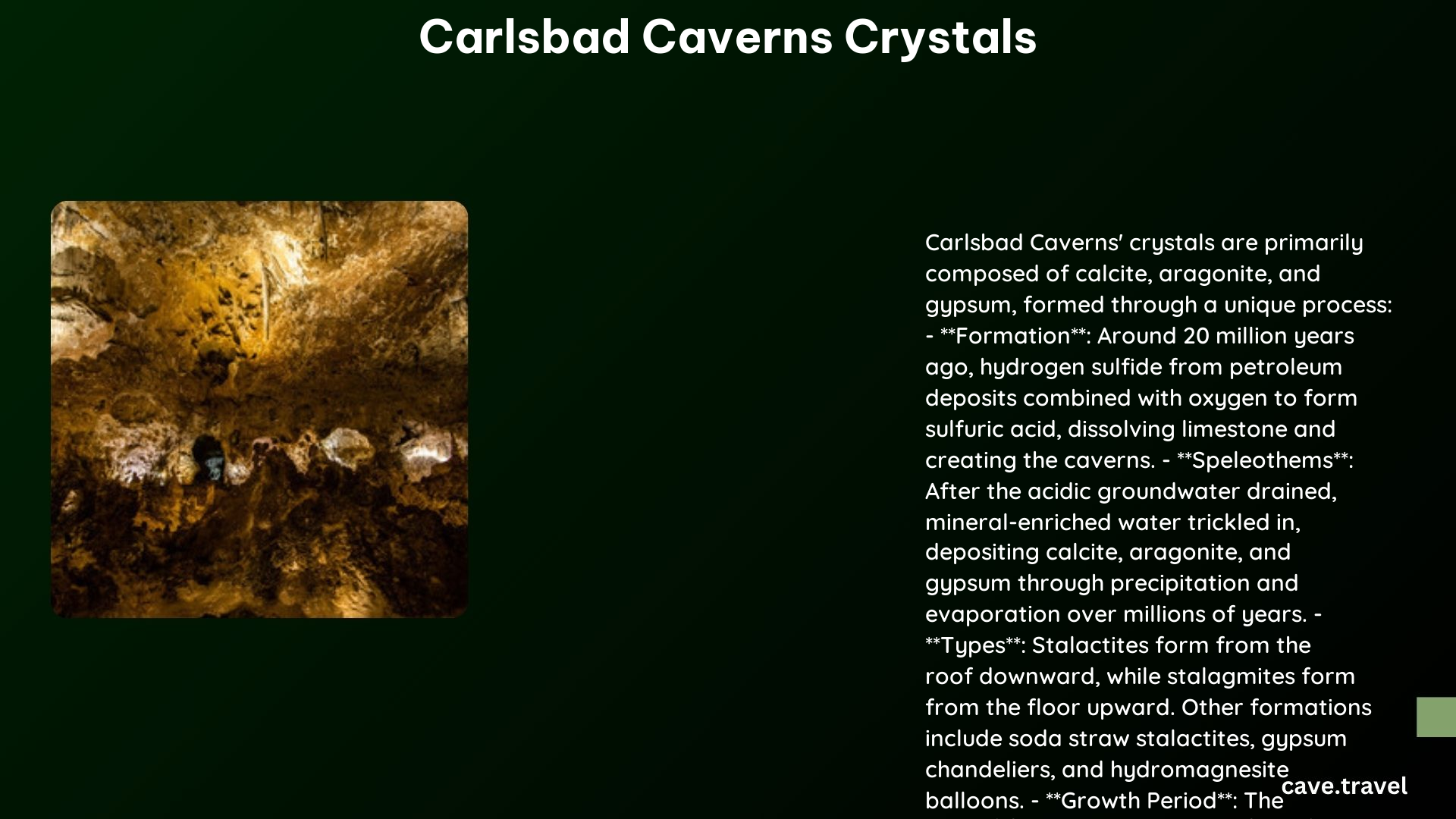Carlsbad Caverns, located in New Mexico, is a natural wonder renowned for its spectacular crystal formations. These underground marvels, shaped over millions of years, showcase the intricate beauty of geological processes. From towering stalactites to delicate helictites, the caverns house a diverse array of speleothems that captivate visitors and scientists alike. The unique combination of sulfuric and carbonic acid has created an environment where these formations grow rapidly compared to other caves, resulting in an unparalleled subterranean landscape.
What Are the Main Types of Crystal Formations in Carlsbad Caverns?

The caverns boast an impressive variety of crystal formations, each with its own unique characteristics:
- Stalactites and Stalagmites
- Columns
- Draperies and Flowstone
- Helictites
- Popcorn and Cave Pearls
- Rimstone Dams and Mirror Lake
Let’s explore each of these formations in detail:
How Do Stalactites and Stalagmites Form?
Stalactites and stalagmites are perhaps the most recognizable cave formations:
- Stalactites: These hang from the ceiling and form when water drips slowly, depositing calcite. They begin as thin “soda straws” and can grow into larger, more complex shapes over time.
- Stalagmites: Rising from the floor, these formations result from water falling and splashing over a wide area.
The rate of water drip determines their shape:
– Fast-growing stalactites are long and thin
– Slow-growing stalactites are stubby
When a stalactite and stalagmite meet, they form a column.
What Makes Columns Unique?
Columns are impressive formations that occur when stalactites and stalagmites grow together and merge. The Giant Dome in the Big Room is a prime example, standing an impressive 60 feet tall.
How Do Draperies and Flowstone Develop?
These formations create some of the most visually striking features in the caverns:
- Draperies: Formed when water runs down a slanted ceiling, creating thin, translucent sheets of calcite that resemble curtains.
- Flowstone: Created by water flowing over the surface of walls or floors, depositing layers of calcite and creating smooth, flowing surfaces.
What Are Helictites and Why Are They So Unusual?
Helictites are among the most intriguing formations in Carlsbad Caverns:
- They grow seemingly without regard to gravity
- Their twisting shapes are governed by crystal structures, impurities, and the force of water under pressure
- They often defy expectations, growing in various directions and creating complex, delicate structures
How Do Popcorn and Cave Pearls Form?
These smaller formations add texture and variety to the cave landscape:
- Popcorn: Created when water evaporates and leaves behind aragonite crystals
- Cave Pearls: Form in pools of water where layers of calcite build up around a tiny object, such as a grain of sand
What Are Rimstone Dams and Mirror Lake?
These formations are related to water movement within the cave:
- Rimstone Dams: Formed where water flows slowly on the floor, creating barriers
- Mirror Lake: A drip pool formed and fed by surface water, creating a reflective surface that enhances the cave’s beauty
What Is the Geological Significance of Carlsbad Caverns Crystals?

The crystal formations in Carlsbad Caverns are not just visually stunning; they also hold great geological significance:
- Composition: Primarily composed of calcite, a mineral form of calcium carbonate
- Age: Part of the Capitan Reef, a 250-million-year-old fossil reef
- Formation Process: Unique combination of sulfuric and carbonic acid dissolution
- Growth Rate: Faster than many other cave systems due to specific geological conditions
- Color Variations: Determined by trace constituents in the minerals
- Environmental Indicators: Changes in growth patterns can indicate shifts in climate and rainfall over time
What Are Some Notable Measurements in Carlsbad Caverns?
The caverns boast some impressive statistics:
| Feature | Measurement |
|---|---|
| The Big Room Length | 4,000 feet |
| The Big Room Width | 625 feet |
| The Big Room Height | 255 feet |
| Crystal Springs Dome | Largest active formation |
How Can Visitors Experience Carlsbad Caverns Crystals?
Visitors have several options to explore the crystal formations:
- Self-Guided Tours:
- Take the elevator or hike down to the Big Room
-
Explore main areas at your own pace
-
Ranger-Guided Tours:
- In-depth information about geology and history
-
Options include King’s Palace, Left Hand Tunnel, and Wild Cave tours
-
Backcountry Tours:
- For adventurous visitors
- Involve crawling, climbing, and exploring less accessible areas
What Are the Tour Schedules, Costs, and Rules?
- Schedules: Vary by season; check the official park website for current information
- Costs:
- Self-guided tours included in general admission
- Ranger-guided tours may require additional fees
- Rules:
- Stay on designated trails
- Do not touch formations
- Follow all instructions from park rangers
What Amenities Are Available?
Visitors can enjoy several amenities within the caverns:
– Restrooms
– Restaurant
– Gift shop
By exploring Carlsbad Caverns and its magnificent crystal formations, visitors can witness firsthand the incredible geological processes that have shaped our planet over millions of years. The diverse array of speleothems, from towering columns to delicate helictites, offers a unique glimpse into the underground world and the slow, patient work of nature in creating these subterranean masterpieces.
References:
– https://npshistory.com/publications/cave/index.htm
– https://www.nps.gov/cave/learn/nature/geologicformations.htm
– https://carlsbadcavernstradingco.com/cavern-formation/
